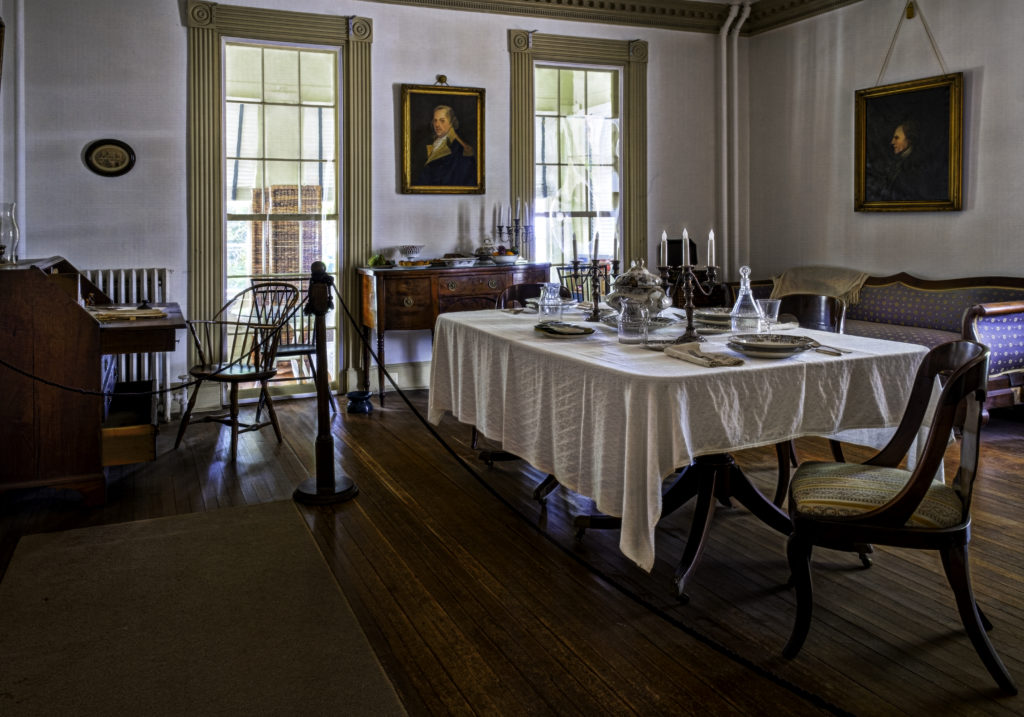 Philip R. Fendall, a local businessman and member of both the Lee family of Virginia and the Fendall family of Maryland, had his home built on the site in 1785. From 1785 to 1903, the house was a residence for several generations of the Lee family as well as enslaved and free people of African descent who lived and worked on the property. This period of residency was interrupted during the American Civil War when the Union Army turned the property into a hospital for wounded soldiers known as the Grosvenor Branch Hospital between 1863-65.
Philip R. Fendall, a local businessman and member of both the Lee family of Virginia and the Fendall family of Maryland, had his home built on the site in 1785. From 1785 to 1903, the house was a residence for several generations of the Lee family as well as enslaved and free people of African descent who lived and worked on the property. This period of residency was interrupted during the American Civil War when the Union Army turned the property into a hospital for wounded soldiers known as the Grosvenor Branch Hospital between 1863-65.
By 1903, the house had been purchased by Robert Downham, a prominent Alexandria liquor purveyor, who resided with his family in the house until Prohibition forced him to downsize. In 1937, John L. Lewis moved into the home. As president of the United Mine Workers of America and founder of the Congress of Industrial Organizations, Lewis was one of the most powerful and controversial labor leaders in American history. He lived in this house during the height of his career. Upon Lewis’ death in 1969, the future of the house was threatened until the Virginia Trust for Historic Preservation (VTHP) purchased it and opened it as a house museum in 1974.
Collections
The house and its collections present a timeline of nineteenth and early twentieth century history and family life. Furnishings on display include a large collection of Lee family items and period pieces produced by local and regional craftsmen. The museum exhibits one of the largest public collections of furniture manufactured by the Green Furniture Company who operated one of the the largest furniture factories in Alexandria during the nineteenth century.
Gardens
When Philip R. Fendall had the house built, the property needed to support all the functions of a large household which included as many as fifteen enslaved men, women, and children. According to the 1796 fire assurance policy, Mr. Fendall filled up the half-acre yard with stables, laundries, a rabbit house, a pigeon house, a two-story wooden slave dwelling, a warehouse, and his office. A kitchen garden was also included.
By the time Louis and Harriott Cazenove purchased Lee-Fendall House in 1850, the needs of city dwellers had changed. The Industrial Revolution had removed the need for extensive on-site production of foodstuffs. The garden could be turned to more ornamental purposes. It had been long suspected that the Cazenoves complemented their 1850-52 renovation of the mansion with a full renovation of the yard. In 2010, an archaeological excavation funded by the Save America’s Treasures grant program was conducted by the Louis Berger Group of Washington, DC. The excavations revealed the most complete nineteenth century urban landscape uncovered to date in Alexandria and confirmed that the Cazenoves had completely overhauled the Lee-Fendall House landscape. The full garden report can be read here: 
Archaeological-Investigation-Lee-Fendall-Garden-Final-Report
Today, a beautiful, award-winning half-acre garden complements the Lee-Fendall House. Development of the garden began in 1974 as a labor of love by the Alexandria Council of Garden Clubs. The Council established an endowment fund which continues to support a portion of the garden’s ongoing maintenance and restoration costs. A rose garden grows many varieties of heritage roses. An herb garden recalls how herbs were used as flavoring agents, medicine, insect repellents, and fragrances. English boxwoods line the brick path and squirrels, a symbol on the Lee family coat-of-arms, scamper across the lawn.
Trees of particular interest in the garden are a black walnut, ginkgo, and magnolia which were planted circa 1852. Peer beneath the magnolia for a glimpse of the tombstone of Eleanor Fendall (1708-1759), mother of Philip R. Fendall. There is no grave, the stone was saved from destruction and brought to the property in her memory.
Ongoing Preservation
Once charged with saving the house from demolition, today the VTHP is committed to implementing a preservation strategy that will reverse centuries of deferred maintenance. The organization’s goal is to improve access to the building and improve the overall visitor experience, while preserving and documenting the structure’s important and unique historic features.
The VTHP concentrated its initial efforts on a major structural restoration in 2005. The main structural beam and two sills were replaced. The replacement of a third sill will complete the structural restoration phase. These efforts have been made possible by grant funding from the federal government, the Commonwealth of Virginia, and the City of Alexandria, as well as contributions from numerous private foundations and individuals. The continued support of these groups, and of others, will be necessary to keep the Lee-Fendall House standing for future generations.
Ongoing projects include stabilization and repair of our historic brick garden wall as well as external restoration of the home’s siding, paint, and decorative elements. We are also fundraising for a Historic Structures Report, the first in our history, that will reveal much about how the home has changed over time as well as identify areas for future preservation efforts.
To contribute to the preservation of the Lee-Fendall House donate here or contact us at contact@leefendallhouse.org or 703-548-1789.
Recommended Sites:
Historic House Museum Consortium of Washington D.C. – over 40 sites open to the public as museums and historic attractions in the greater Washington D.C. area.
Stratford Hall – Constructed in 1738, Stratford Hall is a historic home of the Lee Family of Virginia.


Pingback: Lee-Fendall House's Garden Wall Collapses! - The Zebra